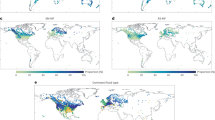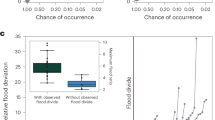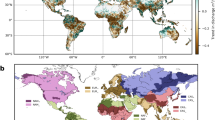Abstract
Riverine floods that occur simultaneously over multiple regions often lead to amplified societal and environmental impacts compared to individual events. However, the pattern and mechanisms governing the global interconnection of peak river discharge across spatially distant and proximate locations remain largely unexplored. Here, on the basis of a global annual peak discharge database from 4,407 observational hydrometric stations, we identify hubs for remotely linked discharge peaks spanning thousands of kilometres. We show increasing trends in the number of remotely linked watersheds and the total drainage area, pointing to amplified synchronization of global peak river discharge since the 1980s. Ocean–atmosphere oscillations, through the perturbation of both temperature and precipitation anomalies, dictate the global coupling pattern and temporal evolution of discharge peaks. Our findings highlight an emergent profile of global peak river flow in a warming climate that can benefit coordinated flood risk management.
This is a preview of subscription content, access via your institution
Access options
Access Nature and 54 other Nature Portfolio journals
Get Nature+, our best-value online-access subscription
$32.99 / 30 days
cancel any time
Subscribe to this journal
Receive 12 print issues and online access
$259.00 per year
only $21.58 per issue
Buy this article
- Purchase on SpringerLink
- Instant access to full article PDF
Prices may be subject to local taxes which are calculated during checkout




Similar content being viewed by others
Data availability
The annual peak discharge dataset is available at https://www.bafg.de/GRDC/. The meteorological variables are available at https://cds.climate.copernicus.eu/cdsapp#!/dataset/reanalysis-era5-single-levels?tab=eqc and https://cds.climate.copernicus.eu/cdsapp#!/dataset/reanalysis-era5-pressure-levels?tab=overview. The monthly climate indices are available at https://www.esrl.noaa.gov/psd/data/climateindices/list/. The Land-Use Harmonization data are available at https://luh.umd.edu/. Version 1.3 of the Global Reservoir and Dam product is available at https://www.globaldamwatch.org/grand/.
Code availability
The source code for this study is available via Figshare at https://doi.org/10.6084/m9.figshare.26139493.v4 (ref. 50). The code is implemented in Python (version 3.8.8). Base maps are generated using the GeoPandas Python module with Natural Earth data (https://www.naturalearthdata.com/).
References
Merz, B. et al. Causes, impacts and patterns of disastrous river floods. Nat. Rev. Earth Environ. 2, 592–609 (2021).
Tellman, B. et al. Satellite imaging reveals increased proportion of population exposed to floods. Nature 596, 80–86 (2021).
Kreibich, H. et al. The challenge of unprecedented floods and droughts in risk management. Nature 608, 80–86 (2022).
Raymond, C. et al. Understanding and managing connected extreme events. Nat. Clim. Change 10, 611–621 (2020).
Zscheischler, J. et al. A typology of compound weather and climate events. Nat. Rev. Earth Environ. 1, 333–347 (2020).
Europe’s floods top 2013 disaster bill according to Munich Re. news.com.au https://www.news.com.au/finance/europes-floods-top-2013-disaster-bill-according-to-munich-re/news-story/e7d8826d655a9a4a465211989750bace (2013).
Gaupp, F., Hall, J., Hochrainer-Stigler, S. & Dadson, S. Changing risks of simultaneous global breadbasket failure. Nat. Clim. Change 10, 54–57 (2019).
Kornhuber, K. et al. Amplified Rossby waves enhance risk of concurrent heatwaves in major breadbasket regions. Nat. Clim. Change 10, 48–53 (2019).
Financial Management of Flood Risk (OECD, Publishing, 2016).
Zhang, S. et al. Reconciling disagreement on global river flood changes in a warming climate. Nat. Clim. Change 12, 1160–1167 (2022).
Boers, N. et al. Complex networks reveal global pattern of extreme-rainfall teleconnections. Nature 566, 373–377 (2019).
Mondal, S., Mishra, K. A., Leung, R. & Cook, B. Global droughts connected by linkages between drought hubs. Nat. Commun. 14, 144 (2023).
Su, Z., Meyerhenke, H. & Kurths, J. The climatic interdependence of extreme-rainfall events around the globe. Chaos 32, 043126 (2022).
Ward, P. J. et al. Strong influence of El Nino Southern Oscillation on flood risk around the world. Proc. Natl Acad. Sci. USA 111, 15659–15664 (2014).
Steptoe, H., Jones, S. E. O. & Fox, H. Correlations between extreme atmospheric hazards and global teleconnections: implications for multihazard resilience. Rev. Geophys. 56, 50–78 (2018).
Ham, Y.-G., Kim, J.-H. & Luo, J.-J. Deep learning for multi-year ENSO forecasts. Nature 573, 568–572 (2019).
Blöschl, G. Flood generation: process patterns from the raindrop to the ocean. Hydrol. Earth Syst. Sci. 26, 2469–2480 (2022).
Jiang, S., Tarasova, L., Yu, G. & Zscheischler, J. Compounding effects in flood drivers challenge estimates of extreme river floods. Sci. Adv. 10, eadl4005 (2024).
Yang, L. et al. Climate more important for Chinese flood changes than reservoirs and land use. Geophys. Res. Lett. 48, e2021GL093061 (2021).
Blöschl, G. et al. Changing climate shifts timing of European floods. Science 357, 588–590 (2017).
Blöschl, G. et al. Changing climate both increases and decreases European river floods. Nature 573, 108–111 (2019).
Han, J. et al. Streamflow seasonality in a snow-dwindling world. Nature 629, 1075–1081 (2024).
Berghuijs, W. R., Allen, S. T., Harrigan, S. & Kirchner, J. W. Growing spatial scales of synchronous river flooding in Europe. Geophys. Res. Lett. 46, 1423–1428 (2019).
Dai, P. & Nie, J. Robust expansion of extreme midlatitude storms under global warming. Geophys. Res. Lett. 49, e2022GL099007 (2022).
Yang, Y., Yang, L., Chen, X., Wang, Q. & Tian, F. Climate leads to reversed latitudinal changes in Chinese flood peak timing. Earth’s Future 10, e2022EF002726 (2022).
Richard, Y., Pohl, B. & Fauchereau, N. Influence of the Madden–Julian Oscillation on southern African summer rainfall. J. Clim. 20, 4227–4242 (2007).
Du, D. et al. Increase in MJO predictability under global warming. Nat. Clim. Change 14, 68–74 (2023).
Wang, J., He, J., Liu, X. & Wu, B. Interannual variability of the Meiyu onset over Yangtze-Huaihe River Valley and analyses of its previous strong influence signal. Chin. Sci. Bull. 54, 687–695 (2009).
Xu, B. & Li, G. A potential seasonal predictor for summer rainfall over eastern China: Spring Eurasian snowmelt. J. Clim. 37, 1999–2012 (2024).
McCabe, G. J. & Dettinger, M. D. Primary modes and predictability of year-to-year snowpack variations in the western United States from teleconnections with Pacific Ocean climate. J. Hydrometeorol. 3, 13–25 (2002).
Rogers, J. C. & Van Loon, H. The seesaw in winter temperatures between Greenland and northern Europe. Part II: Some oceanic and atmospheric effects in middle and high latitudes. Mon. Weather Rev. 107, 509–519 (1979).
Beck, H. E. et al. Global evaluation of runoff from 10 state-of-the-art hydrological models. Hydrol. Earth Syst. Sci. 21, 2881–2903 (2017).
Frasson, R. P. d. M., Schumann, G. J. P., Kettner, A. J., Brakenridge, G. R. & Krajewski, W. F. Will the Surface Water and Ocean Topography (SWOT) satellite mission observe floods? Geophys. Res. Lett. 46, 10435–10445 (2019).
Yang, L., Wang, L., Li, X. & Gao, J. On the flood peak distributions over China. Hydrol. Earth Syst. Sci. 23, 5133–5149 (2019).
Gudmundsson, L., Do, H. X., Leonard, M. & Westra, S. The Global Streamflow Indices and Metadata Archive (GSIM) – Part 2: Quality control, time-series indices and homogeneity assessment. Earth Syst. Sci. Data 10, 787–804 (2018).
Lehner, B. et al. High‐resolution mapping of the world’s reservoirs and dams for sustainable river‐flow management. Front. Ecol. Environ. 9, 494–502 (2011).
Hurtt, G. C. et al. Harmonization of global land use change and management for the period 850–2100 (LUH2) for CMIP6. Geosci. Model Dev. 13, 5425–5464 (2020).
Quian Quiroga, R., Kreuz, T. & Grassberger, P. Event synchronization: a simple and fast method to measure synchronicity and time delay patterns. Phys. Rev. E 66, 041904 (2002).
Boyd, M. J. A storage-routing model relating drainage basin hydrology and geomorphology. Water Resour. Res. 14, 921–928 (1978).
Villarini, G. On the seasonality of flooding across the continental United States. Adv. Water Res. 87, 80–91 (2016).
Blondel, V. D., Guillaume, J.-L., Lambiotte, R. & Lefebvre, E. Fast unfolding of communities in large networks. J. Stat. Mech. 2008, P10008 (2008).
Hersbach, H. et al. The ERA5 global reanalysis. Q. J. R. Meteorol. Soc. 146, 1999–2049 (2020).
Tarasova, L. et al. A process‐based framework to characterize and classify runoff events: The event typology of Germany. Water Resour. Res. 56, e2019WR026951 (2020).
Kader, G. D. & Perry, M. Variability for categorical variables. J. Stat. Educ. 15, 2007 (2017).
Sen, P. K. Estimates of the regression coefficient based on Kendall’s Tau. J. Am. Stat. Assoc. 63, 1379–1389 (1968).
Zeng, Z. et al. A reversal in global terrestrial stilling and its implications for wind energy production. Nat. Clim. Change 9, 979–985 (2019).
Burnham, K. P. & Anderson, D. R. Model Selection and Multimodel Inference: a Practical Use of the Information-Theoretic Approach 2nd edn (Springer, 2002).
Granger, C. W. Investigating causal relations by econometric models and cross-spectral methods. Econometrica 37, 424–438 (1969).
Draper, N. R. & Smith, H. Applied Regression Analysis (Wiley, 1998).
Yang, Y. et al. Synchronization of global peak river discharge since the 1980s. Figshare https://doi.org/10.6084/m9.figshare.26139493.v4 (2024).
Acknowledgements
Y.Y., L.Y. and Q.W. are supported by the National Science Foundation of China (grant number 52379012), the Fundamental Research Funds for the Central Universities (grant number 0209-14380133), the ‘GeoX’ Interdisciplinary Project of the Frontiers Science Center for Critical Earth Material Cycling (grant number 20250204) and the Basic Research Program of Jiangsu Province (grant number BK20231541). The flood network in this paper is calculated on the computing facilities in the High-Performance Computing Center of Nanjing University.
Author information
Authors and Affiliations
Contributions
Conceptualization: Y.Y. and L.Y. Methodology: Y.Y., L.Y. and G.V. Investigation: Y.Y., L.Y., G.V. and F.Z. Visualization: Y.Y. and L.Y. Funding acquisition: L.Y. Project administration: L.Y. Supervision: L.Y. Writing (original draft): Y.Y. and L.Y. Writing (review and editing): all authors.
Corresponding author
Ethics declarations
Competing interests
The authors declare no competing interests.
Peer review
Peer review information
Nature Climate Change thanks Somnath Mondal, Nasser Najibi and the other, anonymous, reviewer(s) for their contribution to the peer review of this work.
Additional information
Publisher’s note Springer Nature remains neutral with regard to jurisdictional claims in published maps and institutional affiliations.
Supplementary information
Supplementary Information
Supplementary Figs. 1–26 and Tables 1–3.
Rights and permissions
Springer Nature or its licensor (e.g. a society or other partner) holds exclusive rights to this article under a publishing agreement with the author(s) or other rightsholder(s); author self-archiving of the accepted manuscript version of this article is solely governed by the terms of such publishing agreement and applicable law.
About this article
Cite this article
Yang, Y., Yang, L., Villarini, G. et al. Synchronization of global peak river discharge since the 1980s. Nat. Clim. Chang. 15, 1084–1090 (2025). https://doi.org/10.1038/s41558-025-02427-6
Received:
Accepted:
Published:
Issue date:
DOI: https://doi.org/10.1038/s41558-025-02427-6



